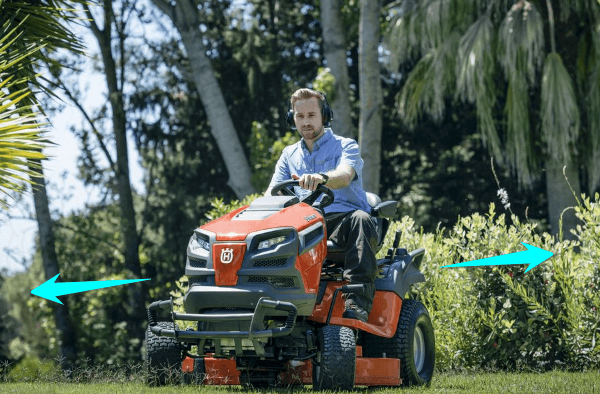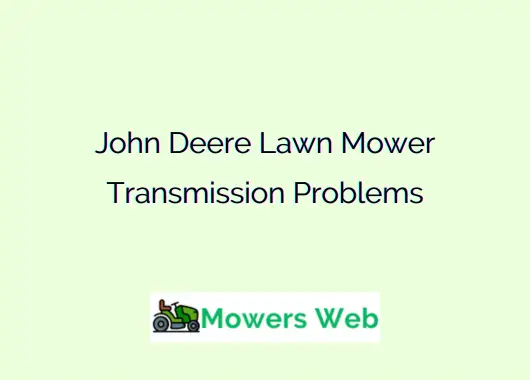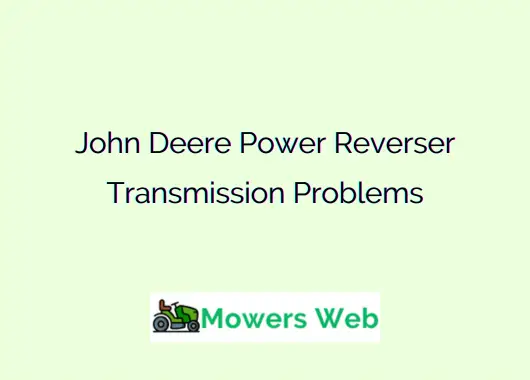If you’re a proud owner of a Husqvarna riding mower, you know how convenient and efficient these machines can be.
However, it can be frustrating when your trusty Husqvarna suddenly refuses to move forward or backward.
Before you call in the professionals, let’s dive into some common issues and troubleshooting steps you can take to get your mower back in action.
Let’s jump in.

Husqvarna Won’t Go Forward or Reverse
1. Check the Drive Belt
The first thing to inspect is the drive belt. Over time, belts can wear out or become loose, preventing the transmission from engaging properly.
Ensure that the drive belt is in good condition and properly tensioned. If it’s frayed, cracked, or loose, it’s time for a replacement.
2. Inspect the Transmission Fluid
Low or dirty transmission fluid can hinder the mower’s ability to move. Locate the transmission’s dipstick, and check the fluid level and condition.
If it’s low or looks dirty, it’s time for a change. Using the wrong type of fluid can also cause issues, so consult your owner’s manual for the correct fluid specifications.
Read Low Oil Symptoms in Lawn Mowers (Don’t Ignore These Signs)
3. Look for Leaks
Leaks in the transmission system can cause a loss of hydraulic pressure, leading to mobility issues.
Inspect the system for any visible leaks, paying close attention to hoses, fittings, and the transmission housing. If you spot any leaks, replace or repair the affected components promptly.
Read Husqvarna Weed Eater Won’t Stay Running(FIXED)
4. Check the Neutral Position
Sometimes, the simplest solution is the right one. Ensure that the mower is not stuck in the neutral position, as this will prevent it from moving forward or backward.
Check the neutral lever or pedal and make sure it’s in the proper position for driving.
5. Damaged Wheel Drive Motors
Husqvarna mowers typically have individual wheel drive motors that power each wheel independently.
If one or more of these motors become damaged or fail, it can result in uneven movement or a complete loss of motion.
Inspect the wheel drive motors for visible damage or unusual sounds. Replacing a faulty motor may be necessary.
6. Steering Linkage Issues
In some cases, problems with the steering linkage can affect the mower’s ability to move smoothly. If the linkage is bent, disconnected, or damaged, it can interfere with the steering and mobility of the mower.
Check the linkage for any issues and ensure it is properly connected and functioning.
Read Husqvarna Anti Sway Rod Installation(In 3 Quick Steps)
7. Engine-Related Problems
While the transmission is responsible for the mower’s movement, engine issues can indirectly impact mobility.
If the engine is not running correctly or lacks power, it can prevent the mower from moving efficiently.
Address any engine problems, such as spark plug issues, fuel system problems, or carburetor issues, to restore proper performance.
8. Drive Control Cable Adjustment
The drive control cable connects the operator control lever to the transmission, allowing you to control the mower’s speed and direction.
If this cable is misadjusted or too tight, it can prevent the transmission from engaging correctly. Adjust the drive control cable according to the manufacturer’s instructions to ensure proper movement.
9. Wheel or Tire Problems
Damaged or flat tires can also affect your mower’s mobility. Check all four tires for proper inflation and any signs of damage, such as punctures or worn treads.
Replace or repair damaged tires and ensure they are properly inflated to the recommended pressure.
Read 9 Common Husqvarna 445 Problems(With Solutions)
Troubleshooting Husqvarna won’t go forward or reverse
Air in the Hydraulic System
Air bubbles in the hydraulic system can disrupt the flow of fluid, affecting the mower’s movement. Bleeding the system can resolve this issue.
Refer to your owner’s manual for specific instructions on how to bleed the hydraulic system properly. This may involve loosening specific valves or using a hydraulic bleed kit.
Clean the Cooling Fins
Overheating can also affect the transmission’s performance. Clean the cooling fins to ensure proper heat dissipation.
Use a soft brush or compressed air to remove debris and dirt from the cooling fins. Overheating can lead to premature wear of transmission components, so regular cleaning is crucial.
Verify the Traction Drive
Inspect the traction drive belt and pulleys for any damage. A damaged belt or pulley can prevent the mower from moving. Check for signs of wear, cracking, or fraying on the belt.
Additionally, ensure that the pulleys are in good condition and properly aligned. Replace any damaged components as needed.
Read Husqvarna Z254F Drive Belt Tension Spring(Explained)
Check the Transmission Control Linkage
The transmission control linkage connects the transmission to the operator’s controls.
If this linkage becomes misadjusted or damaged, it can affect the mower’s ability to move.
Inspect the linkage for proper adjustment and any signs of wear or damage. Adjust or replace components as necessary to restore proper function.
When to Seek Professional Help
Contact Husqvarna support here
Electrical Issues
If you’ve ruled out mechanical problems, electrical issues might be the culprit. Faulty wiring or a malfunctioning safety switch can cause mobility problems.
It’s best to leave electrical troubleshooting to a professional electrician or technician who can safely diagnose and repair any wiring or electrical component issues.
Internal Transmission Problems
If you’ve exhausted all DIY options and the issue persists, there could be internal transmission problems. In this case, it’s advisable to consult a certified Husqvarna technician.
Internal transmission repairs are complex and require specialized knowledge and tools, making professional assistance essential.
Read How to Start a Riding Lawn Mower with a Screwdriver(In 5 Steps)
Regular Maintenance
Prevention is often the best remedy. To avoid future mobility issues, adhere to a regular maintenance schedule.
This includes changing the transmission fluid, inspecting and adjusting the drive belt, and keeping the cooling fins clean.
Regular maintenance can extend the life of your Husqvarna mower and reduce the likelihood of unexpected problems.
Problems With Husqvarna Riding Mowers
| Problem | Description | Solutions |
|---|---|---|
| 1. Drive Belt Issues | Drive belts can become loose, frayed, or damaged, affecting the transmission’s engagement. | – Inspect and adjust the drive belt tension. – Replace damaged or worn-out drive belts. |
| 2. Low/Dirty Transmission Fluid | Low or dirty transmission fluid can hinder the mower’s movement; correct fluid level is essential. | – Check and fill the transmission fluid to the recommended level. – Replace old or dirty transmission fluid. |
| 3. Hydraulic System Leaks | Leaks in the hydraulic system can cause a loss of pressure, leading to mobility problems. | – Locate and repair any visible leaks promptly. – Ensure all hydraulic connections are secure. |
| 4. Stuck in Neutral | Ensure the mower isn’t stuck in neutral as it disengages the transmission, preventing movement. | – Check the neutral lever or pedal and ensure it’s in the proper position for driving. |
| 5. Air in Hydraulic System | Air bubbles in the hydraulic system can disrupt fluid flow, impacting the mower’s mobility. | – Bleed the hydraulic system following the manufacturer’s instructions. – Remove air from the system to restore pressure. |
| 6. Overheating (Cooling Fins) | Overheating can affect transmission performance; regularly clean the cooling fins for heat dissipation. | – Clean cooling fins using a soft brush or compressed air to prevent overheating. |
| 7. Traction Drive Belt/Pulley Damage | Inspect the drive belt and pulleys for damage, wear, or misalignment, which can hinder movement. | – Replace damaged drive belts or pulleys. – Ensure proper alignment of pulleys for smooth operation. |
| 8. Transmission Control Linkage Issues | Misadjusted or damaged linkage can affect the mower’s ability to move; ensure proper functioning. | – Inspect and adjust the transmission control linkage according to the manufacturer’s recommendations. |
| 9. Electrical Problems | Faulty wiring or safety switch malfunctions can lead to mobility issues; consult a professional for electrical troubleshooting. | – Seek assistance from an electrician or technician to diagnose and repair electrical issues. |
| 10. Internal Transmission Problems | Complex internal issues may require professional attention; consult a certified technician. | – Contact a certified Husqvarna technician to diagnose and repair internal transmission problems. |
| 11. Regular Maintenance | Prevent mobility issues with regular maintenance, including fluid changes, belt inspections, and cleaning. | – Follow the manufacturer’s maintenance schedule for fluid changes, belt inspections, and cleaning. |
Read Husqvarna Z254 Wiring Diagram(Explained With Diagrams)
Final Remarks
Your Husqvarna mower not moving can be a frustrating experience, but with the right knowledge and troubleshooting steps, you can often diagnose and resolve the issue yourself.
Remember to stay safe while working on your mower, and if you’re ever unsure about a repair, consult a professional technician.
FAQs
How often should I check my Husqvarna’s drive belt?
It’s a good practice to inspect the drive belt before each mowing season and periodically throughout the year.
Can I use any type of transmission fluid for my Husqvarna mower?
No, it’s essential to use the specific type of transmission fluid recommended in your owner’s manual to ensure proper performance.
What should I do if I can’t find any visible leaks in the transmission system?
Even if leaks aren’t visible, it’s a good idea to have a professional inspect the system, as internal leaks can be challenging to detect.
Why is the neutral position important for my mower?
The neutral position is crucial because it disengages the transmission, allowing you to move the mower manually.
How can I prevent transmission issues in the future?
Regular maintenance, including changing the transmission fluid and inspecting belts, can help prevent transmission problems in the future.




